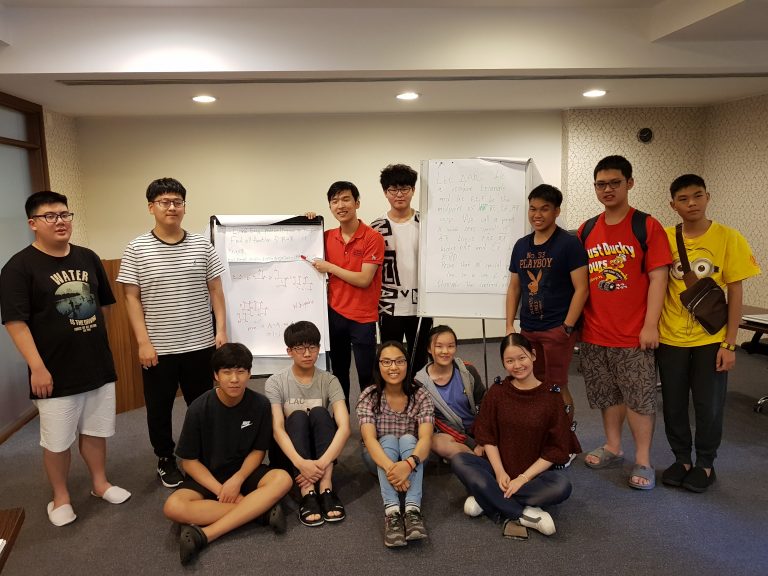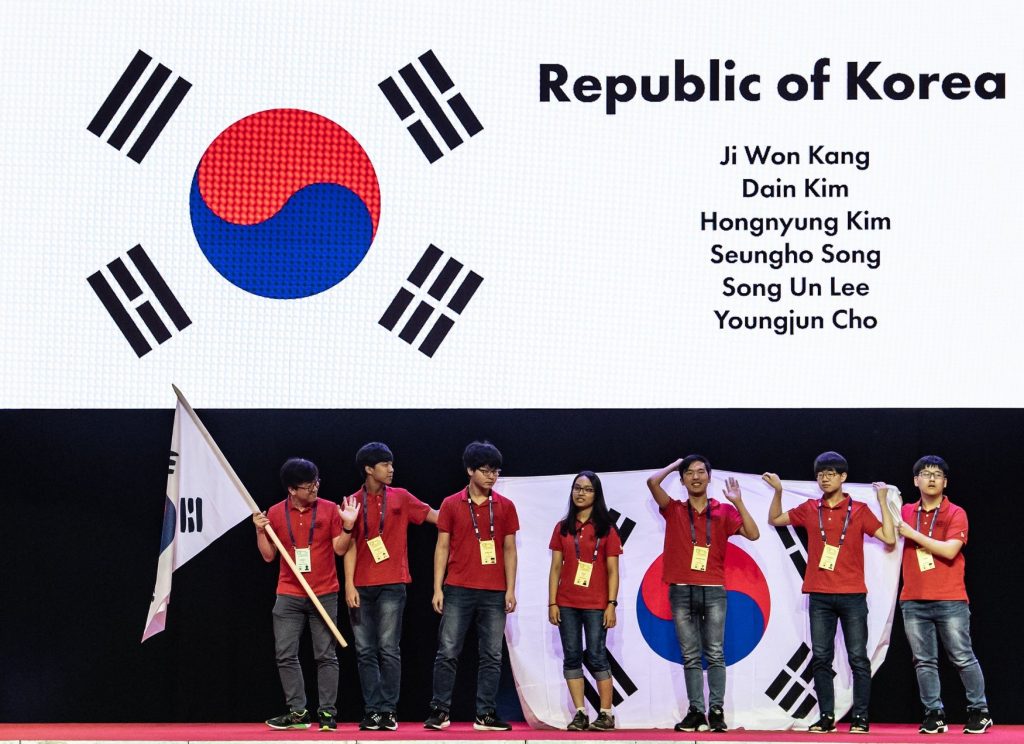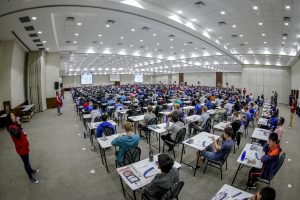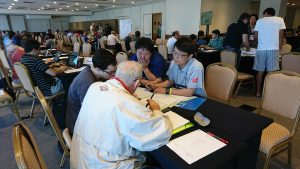2018년 루마니아 클루지나포카에서 열린 제59회 국제수학올림피아드에 다녀왔습니다. 국제수학올림피아드 참가는 저는 2009년, 2011년, 2012년, 2016년, 2017년에 이어 6번째입니다. 이번에는 107개 나라에서 총 594명의 학생이 참가하였습니다. 2016년, 2017년에는 600명이 넘었는데 조금 줄어들었지요. 예전에 적은 것처럼 올해도 후기를 적어볼까 합니다.
- 2012년 국제수학올림피아드 참가후기
- 2016년 국제수학올림피아드 참가후기 (사이언스북스 블로그 연재: 1편, 2편, 3편)
- 2017년 국제수학올림피아드 참가후기
2018년은 우리나라가 국제수학올림피아드에 참가한지 정확히 30년이 되는 해입니다. 올해는 대표학생 6명이 금메달 3개, 은메달 3개를 받았습니다. 학생들의 점수를 합하여 살펴보는 국가별 순위에서는 107개 참가국 중 7위라는 우수한 성적을 거두었습니다. 국가별 순위를 보면 아래와 같습니다.
- 1위: 미국 212점
- 2위: 러시아 201점
- 3위: 중국 199점
- 4위: 우크라이나 186점
- 5위: 태국 183점
- 6위: 대만 179점
- 7위: 대한민국 177점
- 8위: 싱가포르 175점
- 9위: 폴란드 174점
- 10위: 인도네시아 171점
올해 역시 작년과 마찬가지로 우리나라 대표 학생들은 모두 서울과학고 학생이었습니다. 우리 나라 대표 학생들과 그 메달은 아래와 같습니다. 서울과학고가 아닌 최근 대표로는 2년전 국제수학올림피아드에서 만점을 받았던 세종과학고 홍의천 학생이 있었습니다.
- 김홍녕: 총점 32점. 개인순위 27등 (95.62%). 금메달
- 김다인: 총점 31점. 개인순위 34등 (94.44%). 금메달
- 송승호: 총점 31점. 개인순위 34등 (94.44%). 금메달
- 이송운: 총점 28점. 개인순위 87등 (85.50%). 은메달
- 강지원: 총점 28점. 개인순위 87등 (85.50%). 은메달
- 조영준: 총점 27점. 개인순위 111등 (81.45%). 은메달
이 중 김다인 이송운 학생은 작년에 이어 두 번째로 출전하였습니다. 김다인 학생은 이번 팀의 유일한 여학생이었습니다. (한국대표팀에서 김다인 학생 이전에 국제수학올림피아드 대표를 한 여학생으로는 2005년 2006년 두 번에 걸쳐 출전한 경기과학고 남주강씨가 있습니다.) 이제까지 한국대표팀으로 국제수학올림피아드를 나가서 금메달을 두 번 이상 받은 학생은 총 14명이 있고, 그 중 여학생은 이제 김다인 학생을 포함하여 이제 3명이 되었습니다.
2016년부터 우리나라에서는 2월에 루마니아 수도 뷰쿠레스티에서 열리는 루마니아 수학 마스터 대회(Romanian Master of Mathematics)에 출전하고 있습니다. 이 6명의 대표 중 4명, 강지원 김다인, 김홍녕, 이송운 학생은 이미 루마니아 수학 마스터 대회에 한국 대표로 출전한 경험이 있어서 루마니아에 좀더 익숙했을 것입니다. 김홍녕 학생은 올해 루마니아 수학 마스터 대회에서 전체 개인 순위 1위로 금메달을 수상하였는데, 국제수학올림피아드에서도 우리 팀 1위를 하며 큰 기여를 하였습니다.
대표 6명에는 들지 못했지만 최종 후보로 뽑혔던 그 밖의 9명의 학생들은 다음과 같습니다.
고상연 (서울과학고), 권성현 (서울과학고), 김재연 (서울과학고), 노규민 (경기과학고), 박주영 (서울과학고), 안재준 (서울과학고), 이재훈 (서울과학고), 최성준 (세종과학예술영재학교), 허은수 (역삼중)
이번 한국대표팀 단장으로는 인하대 송용진 교수님이 작년처럼 수고해주셨고, 유원대 이승훈 교수님이 단장팀에 합류하셔서 함께 문제 번역 등의 일을 하셨습니다. 학생들을 인솔하다가 시험 후에는 채점 과정에 참여하는 부단장팀에는 저와 아주대 최수영 교수, 그리고 서울대 수리과학부 학생이며 2014년, 2015년 국제수학올림피아드 한국대표였던 김재형 학생이 있었습니다. 그리고 한국과학창의재단에서 연경남 박사님도 오셔서 도와주셨습니다.
이번 국제수학올림피아드 문제별 분야와 출제국은 아래와 같습니다.
- (기하) 그리스
- (대수) 슬로바키아
- (조합) 이란
- (조합) 아르메니아
- (정수) 몽골
- (기하) 폴란드
올해 역시 최근 경향에 맞게 1, 2, 4, 5 문제가 정수, 대수, 조합, 기하 분야 한 문제씩 골고루 나왔습니다. 작년보다 2번 5번 문제가 쉬워졌습니다. 우리나라 대표학생들은 보통 1, 2, 4, 5번 문제를 다들 골고루 잘 하고 어려운 3, 6번 문제를 몇몇이 공략하여 좋은 성적을 거두었습니다. 하지만 올해는 2, 5번 문제가 작년보다 쉬워지는 바람에 다른 강국들도 공략을 잘 하였습니다. 아울러 3번, 6번이 어려워서 우리나라 학생들은 이번에 3번, 6번에서 만점을 받은 사람이 아무도 없었습니다. 전체 참가자 중에 3번 만점은 고작 11명, 6번 만점은 고작 18명이었습니다.

작년에 이어 올해에도 조교로 수고한 서울대 김재형 학생이 해설하는 국제수학올림피아드 풀이 동영상을 제작하였습니다. 촬영장소와 삼각대 및 오디오 장비를 빌려주신 카오스 재단분들께 감사드립니다. 참고로 김재형 학생이 입은 티셔츠는 2018년 여름학교 입교생들을 위하여 Jane Street이라는 Quantitative Trading 회사에서 후원해주신 것입니다. 올해부터 Jane Street은 한국수학올림피아드를 후원해주고 계십니다. 홍콩에서 티셔츠를 큰 상자로 보내주셨지요.

작년처럼 올해도 현지에서 태국 대표팀과 함께 며칠간 현지 공동 캠프를 진행하였습니다. 캠프를 위해 대회날보다 일찍인 7월 3일에 출국하였습니다. 작년처럼 최수영 교수님이 캠프를 위해 큰 수고를 하셨고 김재형 조교 또한 수고를 많이 하였습니다. 저는 창의재단 연경남 박사님과 함께 7월 6일 출국하여 현지에 7월 7일 자정 직후에 도착할 수 있었습니다.

이번 국제수학올림피아드가 열린 도시인 클루지나포카(Cluj-Napoca)는 이런 큰 규모의 인원을 한번에 수용할만한 호텔은 없는 것으로 보였습니다. 단장팀의 경우는 Grand Hotel Italia라는 시내에서 좀 떨어진 멋지고 큰 호텔에 모두 묵었습니다. 하지만 부단장팀은 몇몇 나라별로 쪼개져서 시내의 여러 호텔 혹은 기숙사에 분산 수용되었습니다.
한국팀은 다행히 상당히 괜찮은 위치의 호텔인 Grand Hotel Napoca에 배정되었습니다. 나라별로 여러 호텔에 배정되다보니 제가 공항에 도착하였을 때 밤 늦게 나와계신 주최측 자원봉사자 분께서 제가 어느 호텔에서 자야 하는지 잘 찾지도 못하실 정도로 좀 허술한 면도 있었습니다. 여러 숙소로 나뉘다보니 같은 숙소가 아닌 다른 나라 사람들을 만날 기회가 너무 없었고 학생들끼리 서로 친목을 도모할 기회도 부족하였다는 점이 아쉬웠습니다.
학생들은 모두 2인 1실을 사용하였습니다. 이송운 송승호 학생이 217호, 김다인 학생은 이라크 대표 학생과 219호, 강지원 김홍녕 학생이 301호, 조영준 학생은 나이지리아 대표 학생과 302호를 썼습니다. 김다인 학생의 룸메이트였던 쿠르드에서 온 학생은 우리말을 너무 능통하게 써서 모든 사람들이 깜짝 놀랐습니다. K-POP에 매우 관심이 많아서 EXO의 팬이라는 그 학생 덕분에 김다인 학생은 외국인 룸메이트와 한국어로만 이야기를 주고 받을 수 있었습니다.

Grand Hotel Napoca는 개막식 및 시험이 열린 장소인 Polyvalent Hall과 매우 가까워서 강만 건너면 공원을 가로질러서 금방 걸어갈 수 있었습니다. 하지만 주최측은 항상 대절 버스로 이동하라고 하였는데 사실 버스 안에서 대기하는 시간이면 금방 걸어갈 수 있는 거리였습니다.
우리 팀의 가이드는 고등학생인 Tania Somesfalean이었습니다. 조금 우리말을 할 줄 알아서 원래 북한팀 가이드로 배정되어 있었으나 북한팀이 결국 오지 않은 바람에 한국팀에 배정되었습니다. Tania는 대단히 모범생이라 항상 시간을 꼭 지키게 만들었지만 정작 가보면 우리 팀이 가장 먼저 버스를 탄다든지 하는 경우가 많았습니다. 집에서 호텔까지 거리가 꽤 먼데도 매우 성실하게 도와주었습니다. 우리말도 점점 배우더니 나중에 “교수님” 같은 단어도 잘 썼습니다.
개회식 (7월 8일 일요일)

이번 국제수학올림피아드 개회식은 7월 8일 일요일 오전 11시부터 1시까지 2시간 정도 진행되었습니다. 다른 해와 달리 축사가 매우 많아서 절반을 차지하였습니다. 특히 루마니아 대통령이 직접 와서 연설을 해서 놀랐습니다. 아울러 개막식과 폐막식이 루마니아 국영TV로 생중계되었습니다. 국제수학올림피아드를 처음 만든 나라답게 수학올림피아드에 관한 관심이 많다는 것을 느낄 수 있었습니다.
무대에는 부단장과 학생들, 가이드가 올라갔습니다. 제가 들고간 태극기는 우리가 제작한 것이 아니라 루마니아 주최측에서 제작해준 것인데 좀 허술하였습니다. 조금이라도 오래 서있어야 사진 찍기 좋은데 가이드가 워낙 빨리 무대에서 내려가는 바람에 위에 있는 사진에는 가이드가 나오지 않았습니다.
https://www.youtube.com/watch?v=uoN2ZINYwr8


7월 8일 오후 6시 30분부터 1시간동안 시험장을 미리 답사하는 시간이 있었습니다. 다른 해와 다르게 자기가 사용할 책상까지 직접 가서 앉아볼 수 있었고, 첫날 사용할 답안지 묶음을 확인할 수도 있었습니다. 주최측은 개막식이 끝나자마자 몇 시간만에 시험장으로 바꾸는 기적을 이루어 냈습니다.
시험일 (7월 9일 월요일, 10일 화요일)

시험은 이틀간 아침 9시부터 1시 반까지 4시간 30분으로 예정되어 있었습니다. 늘 그렇듯 아침 일찍 호텔 식당의 줄이 매우 길고 혼잡하였습니다. 첫날 혼란을 본 이후 둘쨋날은 호텔에서 아침 식사를 좀더 일찍부터 제공하였습니다.
첫째날은 시험보는 동안 부단장팀 교수와 조교들은 주최측에서 제공한 단체 관광을 가느냐 아니면 학생들처럼 어딘가 감금되어 학생들이 풀고 있는 문제를 받아서 생각하느냐 선택이 주어졌습니다. 루마니아까지 갔는데 관광을 한 번은 가야하니 다들 관광을 갔지만 몇몇 의욕이 있는 분들은 관광을 포기하고 문제를 몇 시간 먼저 보기 위하여 남았습니다. 우리 조교 김재형 학생 역시 관광을 포기하고 문제 풀기를 선택하였습니다. 이번 관광지는 Turda Salt Mine이라는 소금 광산인데 신비로운 곳이었습니다. 경찰차가 부단장팀 관광버스가 거기까지 가는 동안 한 번도 정차하지 않도록 모든 신호와 교차로를 통제해주어 정말 빠르게 이동할 수 있었습니다. 관광 끝나고 오니 1시였는데, 학생들 시험이 예정보다 30분쯤 늦게 시작되어 2시나 되어서야 학생들이 시험장을 빠져나왔고 그 동안 밖에서 한참을 기다렸습니다.
둘째날은 첫날의 혼란이 수습이 되었는지 시험은 정시에 시작되었습니다. 둘째날은 단체 관광이 없어서 부단장팀 교수님들과 조교는 옆 건물에 가서 9시 반부터 문제지를 받아서 구경(?)을 하고 있었습니다. 생각보다 문제가 풀만한 것이 많았습니다. 매년 그렇듯 단장팀에 계신 분들은 둘째날 시험 중 질의응답 시간이 끝나야 부단장들과 학생들을 만날 수 있습니다. 학생들을 기다리다가 단장팀에 계셨던 교수님들을 시험장 밖에서 만날 수 있었습니다. 학생들이 호텔 음식을 지겨워하여 그날 저녁은 Nobori라는 일식당에서 먹었습니다.
Coordination (7월 11일 수요일, 7월 12일 목요일)
시험이 끝나면 그 다음날부터 이틀간 학생들은 가이드와 함께 주최측이 제공하는 단체 관광을 다닙니다. 하지만 이때부터 단장팀 부단장팀 교수 및 조교들은 매우 바빠집니다. 채점이 진행되기 때문이지요.
보통은 단장팀의 경우 둘째날 시험이 있을때 부단장팀과 학생들이 있는 호텔로 옮겨오는 경우도 많았는데, 올해는 특이하게도 전혀 그런 배려가 없었습니다. 채점 협상(coordination) 역시 단장팀이 묵는 호텔에서 진행되었기 때문에 부단장들은 하루 한 번 제공되는 편도 30분 버스를 타고 학생들로부터 멀리 떨어진 호텔로 이동을 하여야 했습니다. 결국 우버를 애용할 수 밖에 없었지요. 단장팀과 부단장팀 교수들이 서로 협의할 일이 많은데 서로 먼 곳에 있어서 일하기가 매우 힘들었습니다. 게다가 단장팀 분들은 학생들 만날 기회가 너무 적었습니다.
우리팀의 문제별 coordination 일정은 아래와 같았습니다.
- 수요일
- 10시: 2번
- 12시: 4번
- 3시 30분: 1번
- 5시 30분: 5번
- 목요일
- 10시: 3번
- 12시: 6번
보통은 하루 3개씩 이틀간 하는 경우가 많았는데 올해는 더 촉박하게 진행되었습니다. 그 이유는 최종 단장 회의를 목요일 오후 3시 반에 진행하기로 하였기 때문이었습니다. 보통은 모든 점수와 메달을 확정하는 최종 단장 회의를 저녁 먹은 이후에 하였는데, 이번에는 상장 인쇄 시간의 편의 등을 위하여 당긴 것으로 보였습니다.
그래서 화요일 오후부터 학생들 답안지를 공식채점기준표에 맞추어 검토하느라 매우 바쁜 시간을 보냈습니다. 아무튼 여러 우여곡절과 드라마 끝에 한국팀의 성적이 확정되었지요. 모든 채점과 Jury Meeting이 끝난 후 학생들과 이탈리안 레스토랑에서 다시 한번 회식을 하기도 하였습니다.
시상식 (7월 13일 금요일)
시상식이자 폐회식은 7월 13일 오후 2시 30분부터 2시간동안 진행되었습니다. 폐회식동안 저는 가져간 캠코더로 촬영하는 역할을 주로 하였습니다. 공간이 좁은 곳으로 옮겨져서 장소의 중앙 홀에는 메달을 받는 학생만 앉아있고 관중석에 메달을 못 받은 학생들과 단장팀, 부단장팀이 앉아았었습니다. 주최측의 대회 이해가 조금 부족하여 단장팀 부단장팀을 격리시켜놓는 바람에 같이 앉지도 못하는 일도 있었습니다.
보통 그렇듯이 올해도 시상은 점수 순으로 이뤄졌습니다. 동메달 제일 낮은 점수부터 시작하여 점점 점수가 올라가는 식이지요. 국제수학올림피아드에서는 참가 학생의 절반 정도에 금,은,동메달을 주는데 금, 은, 동의 비율이 1:2:3으로 정해져 있습니다. 즉 전체 학생이 600명 가량이니 동메달 이상 받는 300명 가량의 학생들은 앉을 자리가 미리 점수 순으로 지정되어 있었지요.
문제가 어려웠음에도 만점을 받은 학생이 2명이 있었습니다. 영국팀의 Agnijo Banerjee, 미국팀의 James Lin 이 두 학생은 모든 문제를 다 해결하여 제일 앞에 앉았습니다.
개회식처럼 시상식 역시 루마니아 국영방송으로 생중계 되었습니다.
시상식이 끝나고 단체사진을 찍었습니다.

시상식이 끝난 후에는 단장팀이 묵는 숙소에서 파티가 있었습니다. 단장팀 부단장팀 쪽과 학생들 가는 쪽이 나뉘어졌는데 단장팀 부단장팀 가는 쪽은 클래식 음악과 전통음악 연주를 들으면서 식사를 하였지만 학생들이 있는 쪽에서는 EDM 디제잉이 있어서 매우 흥겨운 시간을 보냈습니다. 우리 학생들도 가이드와 함께 인파 속에서 흥겨운 시간을 보냈습니다. 몇몇 분들은 다음날 다리에 쥐가 났다고 할 정도였지요. 사진 공개는 하지 않겠습니다.
귀국 (7월 14일)
클루지나포카에서 비행기를 타고 독일 뮌헨으로 이동한 후 루프트한자 항공을 이용하여 되돌아 왔습니다. 하지만 독일로 이동하는 비행기가 연착이 되어 비행기를 못 타게 될지 매우 걱정이 많았습니다. (사실 비행기 놓쳐서 하루밤 자고 뮌헨 구경하고 가길 희망하는 사람도 있었습니다.) 빠듯하게 비행기를 갈아타다보니 몇몇 학생들의 짐이 제 시간에 연결되지 않았습니다. 그 중 일부는 메달을 짐가방 안에 두었었기 때문에 올해 공항 단체사진 찍을때는 메달이 없었습니다. 마지막이라 아쉬워하며 눈물을 흘린 학생도 있었습니다. 다들 집에 가는게 아쉬웠는지 계속 이야기 나누고 사진 찍으며 공항에서 긴 시간을 보냈습니다.































